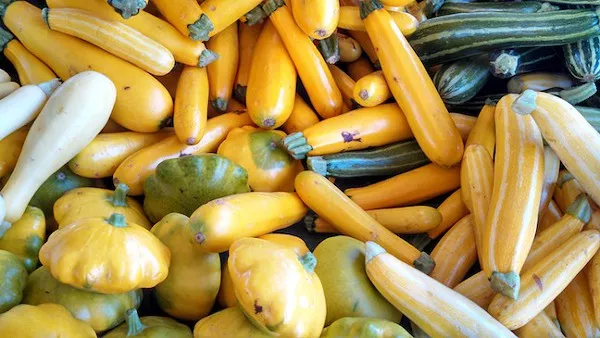Thursday, July 10, 2014
Down and Dirty What to do with that weird squash
Posted By Alison Leininger on Thu, Jul 10, 2014 at 4:14 PM
At the Matthews Community Farmers Market, a woman stands at the Walnut Ridge Farm booth, holding what looks like a light green flying saucer the size of a lunch plate. Even after proprietor Daryl Simpson names the squash's variety - Early White Bush - and describes its taste, she has one remaining question. "So...how would you cook this?"

- Alison Leininger
- An array of Walnut Ridge Farm's squash.
Straight-neck, crook-neck, patty pan, zephyr... squash has been growing in this soil since before the Europeans' arrival, yet it remains a conundrum for many of us. The variety is stunning and picturesque - long, round, yellow, green, purple - but it can also be intimidating.
At Newtown Farms in Waxhaw, Sammy Koenigsberg is growing seven different varieties, all of them falling under the label of "summer squash." Regardless of color or shape, these types possess thin skin and a relatively short shelf life, and fall into three general categories: familiar yellow squash, green zeppelin-shaped zucchini and the flying-saucer patty pan type. While they all display "subtle variations in flavor, shape and color," Koenigsberg says they are interchangeable in cooking. "For example they could all be used in a squash casserole, sautéed with onion, [or] brushed with olive oil and grilled."
So, why bother with more than one variety? According to chef Chris Coleman, who currently plays with five different kinds in the kitchen at The Asbury, "They all bring different things to the table."
After mentioning differing levels of sweetness, he concludes, "For me, it's all about presentation." He describes how the black skin of a zucchini variety he gets from Jamie Swofford of FEBA Farms forms a "beautiful black ring" around each slice, adding interest to a dish. Zephyr squashes boast a flashy yellow and gold skin. Using the "smallest, babiest" squash that Swofford can provide, Coleman serves thin slivers of the raw fruits as both a side and a garnish.
When it comes to cooking this summer staple though, Coleman has bypassed the sauté pan for a food processor. After roasting the squash, he purées it and adds butter, ricotta cheese and some basil to create what he describes as a "freakin' delicious" fondue. He serves it like a hummus, finished with goat cheese and olive oil.
As summer winds down, do not be perturbed when even more squash shows up in the market. Acorn, butternut, spaghetti and the familiar pumpkin all belong to the other side of the family, winter squashes. While they also grow in summer for early fall harvest, their longer maturation time results in thicker rinds and much longer storage life, explaining the misnomer.
These, like their summer cousins, can be treated as a group in the kitchen. Coleman explains that their higher sugar content lends itself to roasting. "Most people just bake it. That's my go-to for winter squash." Which explains how we ended up with a classic American dessert made out of pumpkin.
Armed with this knowledge, you are now ready approach the most bizarre looking squash you can find at the markets. Regardless of shape, color or name, the entire panoply of summer's (and fall's) edible gourds is yours for the eating.














